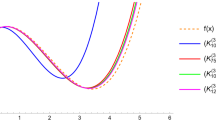A notion of spectral measure with quasipoint spectrum is introduced within the framework of the dynamic picture of interacting physical systems. It is shown that, in the case of conflict interaction with point measures, only quasipoint singularly continuous measures can be transformed into measures with pure point spectrum.
Similar content being viewed by others
References
Y. Kuang, “Basic properties of mathematical population models,” J. Biomath., No. 17, 129–142 (2002).
K. Sigmund, “The population dynamics of conflict and cooperation,” Doc. Math. J. DMV, 1, 487–506 (1998).
M. Bandyopadhyay and J. Chattopadhayay, “Ratio-dependent predator–prey model: effects of environmental fluctuation and stability,” Nonlinearity, No. 18, 913–936 (2005).
Y. Lonzonn, S. Solomon, J. Goldenberg, and D. Mazarsky, “World-size global markets lead to economic instability,” Artificial Life, 357–370 (2003).
J. Hofbauer and K. Sigmund, Evolutionary Games and Population Dynamics, Cambridge University, Cambridge (1998).
K. I. Takahashi and K. M. M. Salam, “Mathematical model of conflict with nonannihilating multi-opponent,” J. Interdiscipl. Math., 9, No. 3, 459–473 (2006).
Y. Kuang and E. Beretta, “Global qualitative analysis of a ratio-dependent predator-prey system,” J. Math. Biol., No. 36, 389–406 (1998).
J. D. Murray, Mathematical Biology I: An Introduction, Springer, Berlin (2002).
S. Albeverio, V. Koshmanenko, and I. Samoilenko, “The conflict interaction between two complex systems: Cyclic migration,” J. Interdiscipl. Math., 11, No. 2, 163–185 (2008).
A. J. Jones, Game Theory: Mathematical Models of Conflict, Horwood, New York (1980).
G. Owen, Game Theory, Academic Press, San Diego (1995).
V. D. Koshmanenko, “Reconstruction of the spectral type of limiting distributions in dynamical conflict systems,” Ukr. Mat. Zh., 59, No. 6, 771–784 (2007); English translation: Ukr. Math. J., 59, No. 6, 841–857 (2007).
T. Karataieva and V. Koshmanenko, “Origination of the singular continuous spectrum in the conflict dynamical systems,” Meth. Funct. Anal. Topol., 14, No. 1, 309–319 (2009).
J. E. Hutchinson, “Fractals and self-similarity,” Indiana Univ. Math. J., 30, 713–747 (1981).
Yu. M. Berezanskii, Selfadjoint Operators in Spaces of Functions of Infinitely Many Variables, American Mathematical Society, Providence, RI (1986).
S. Kakutani, “Equivalence of infinite product measures,” Ann. Math., 49, 214–224 (1948).
M. V. Prats’ovytyi, Fractal Approach to the Investigation of Singular Distributions [in Ukrainian], National Pedagogic University, Kyiv (1998).
K. J. Falconer, Fractal Geometry, Wiley, Chichester (1990).
H. Triebel, Fractals and Spectra Related to Fourier Analysis and Functional Spaces, Birkhäuser, Basel (1997).
V. Koshmanenko, “The structured similarity property for infinite products of measures,” in: Proc. of the Internat. Conf. “Infinite-Dimensional Analysis and Topology” (May 27–June 1, 2009, Yaremche) (2009), pp. 78–79.
S. Albeverio, V. Koshmanenko, and G. Torbin, “Fine structure of the singular continuous spectrum,” Meth. Funct. Anal. Topol., 9, No. 2, 101–119 (2003).
S. Albeverio, V. Koshmanenko, M. Pratsiovytyi, and G. Torbin, “Spectral properties of image measures under infinite conflict interactions,” Positivity, 10, 39–49 (2006).
V. Koshmanenko and N. Kharchenko, “Spectral properties of image measures after conflict interactions,” Theory Stoch. Proc., 10, No. 3–4, 73–81 (2004).
V. Koshmanenko, “Theorem on conflict for a pair of stochastic vectors,” Ukr. Mat. Zh., 55, No. 4, 555–560 (2003); English translation: Ukr. Math. J., 55, No. 4, 671–678 (2003).
V. Koshmanenko, “The theorem of conflict for probability measures,” Math. Meth. Oper. Res., 59, No. 2, 303–313 (2004).
Author information
Authors and Affiliations
Additional information
Translated from Ukrains’kyi Matematychnyi Zhurnal, Vol. 63, No. 2, pp. 187–199, February, 2011.
Rights and permissions
About this article
Cite this article
Koshmanenko, V.D. Quasipoint spectral measures in the theory of dynamical systems of conflict. Ukr Math J 63, 222–235 (2011). https://doi.org/10.1007/s11253-011-0500-5
Received:
Published:
Issue Date:
DOI: https://doi.org/10.1007/s11253-011-0500-5




